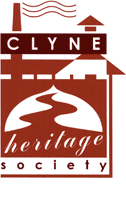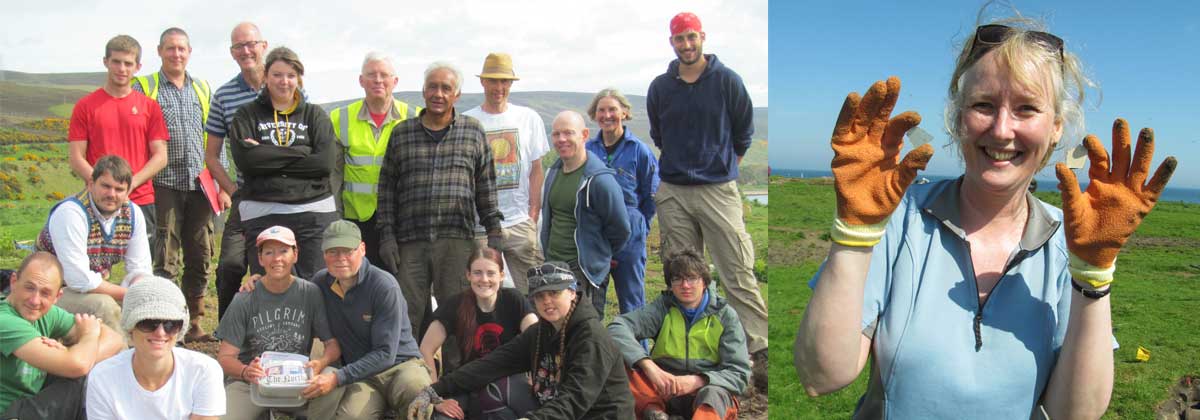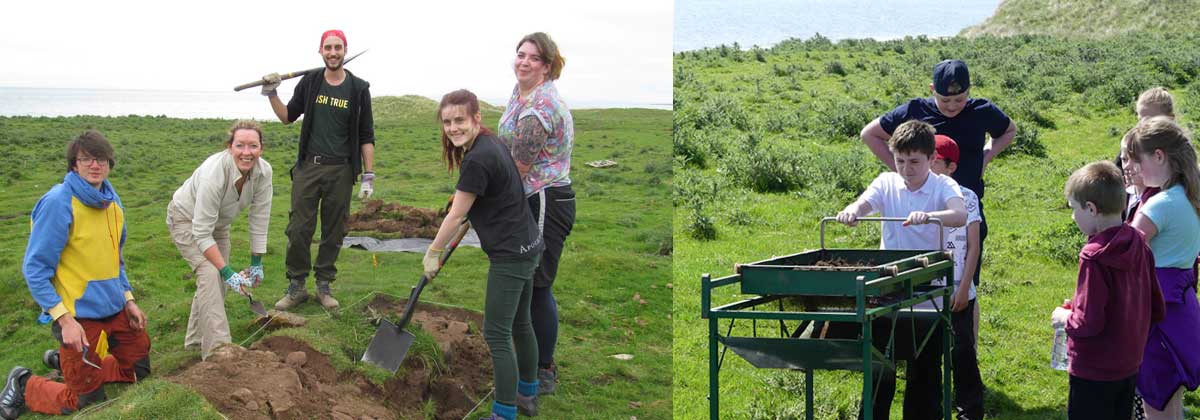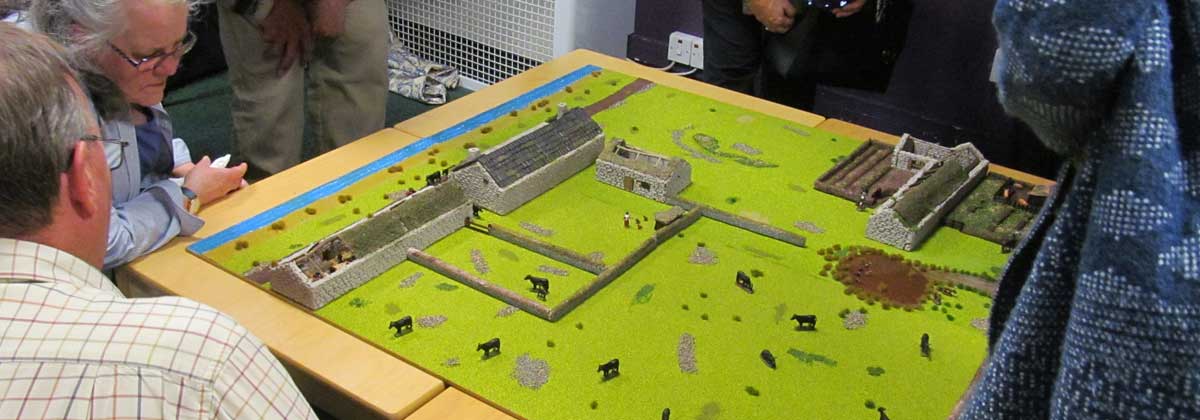
Clyne Heritage Society
The Wilkhouse excavations
Click on any title below for more information.-
Introduction
The archaeological excavation of the 18th Century inn and other building remains at Wilkhouse, Kintradwell, around 3 miles to the north of Brora, drew to a close on Friday, June 2nd, 2017. Clyne Heritage Society hosted the 2-week long dig in partnership with the University of Glasgow and Guard Archaeology Ltd.
The site focused on the old Wilkhouse Inn and associated buildings and enclosures, situated close to the beach, on the old road from Brora to Caithness and well below the present A9. The inn would have been well-used by-passing travellers, including drovers herding cattle from Caithness and North Sutherland to southern markets at Crieff and Falkirk.
The dig was instigated and generously funded by Clyne Heritage Society member and non-executive director of Guard, Donald Adamson, who, after retiring, completed a PhD in 2014, <http://theses.gla.ac.uk/5461/)>concentrating on 17th & 18th Century droving and trade routes. The dig was directed by Warren Bailie of Guard. Donald was particularly interested to compare this site with a droving inn site he previously investigated and excavated at Strachur, Argyllshire.
<http://www.archaeologyreportsonline.com/PDF/ARO17_Tigh_Caol.pdf>.-
Donald Sage’s 1801 visit
Wilkhouse is shown on William Roy’s map of 1747-52, as well as an estate map made by John Kirk in 1772, which is depicted in 3D form, showing front and side windows, gable end chimneys and a slated roof. There is a vivid description of the inn itself in Donald Sage’s ‘Memorabilia Domestica’, when he visited in 1801, en route from Kildonan to Dornoch for his schooling:
“The morning of the day of our departure from under the paternal roof, to attend a public school, at last dawned upon us.... We crossed the Crask, and stopped for refreshment at an inn below Kintradwell, in the parish of Loth, called Wilk-house, which stood close by the shore.
“This Highland hostelry, with its host Robert Gordon and his bustling, talkative wife, were closely associated with my early years, comprehending those of my attendance at school and college. The parlour, the general rendezvous for all comers of every sort and size, had two windows, one in front and another in the gable, and the floor of the room had, according to the prevailing code of cleanliness, about half an inch of sand upon it in lieu of carpeting.
“As we alighted before the door we were received by Robert 'Wilk-house', or 'Robert tighe na faochaig', as he was usually called, with many bows indicative of welcome, whilst his bustling helpmeet repeated the same protestations of welcome on our crossing the threshold. We dined heartily on cold meat, eggs, new cheese, and milk. 'Tam', our attendant, was not forgotten; his pedestrian exercise had given him a keen appetite, and it was abundantly satisfied.”
There are also several other historical references and it is likely that Wilkhouse suffered its demise in 1819, when it was subject to clearance by the Sutherland Estate.-
Starting the Dig
The omens for the first day were good; in glorious sunshine, the 21st Century archaeologists strode down to the site, to be welcomed by a pod of dolphins playing just offshore. It was a truly special start to what would be a truly special dig, with the archaeology and weather both exceeding expectations.
The work commenced with an orientation exercise for the squad, introducing the site to the 20 volunteers. With 2 Americans, a Greek and a German (an A level student who had hitch-hiked the whole way!), together with other students from the Universities of Glasgow and Edinburgh, and members of Clyne Heritage Society, it was a bit of a league of nations and all worked out superbly well throughout the day; ages ranging from 18 to 75.
Trenches, the location of which had been pre-planned from a survey made in September the previous year, were marked out and de-turfing of the grass mounded walls began.
Almost immediately, in the topsoil of a trench in the old inn site, a 2” sized piece of thin, clear window glass was dug up by first time volunteer archaeologist and Clyne Heritage Society member, Doll resident, Brenda Sealey. This was quite an amazing discovery, considering that this building dated from at least the early to mid-18th Century, when windows were an absolute luxury.
When the substantial walls were trowelled down, another quite surprising discovery was made – the stonework of the walling was lime mortared. The significance of this quickly filtered through the dig members; mortared buildings were a rarity for this period, so this was a building which had been constructed at some expense.
Other first day finds included two matching sherds of exquisite 18th Century hand-painted fine porcelain, glass from wine or beer bottles, a butchered sheep’s shin bone and a broken stone used for grinding in a grain quern.
The building around 100m to the SW of, and to the landward side of the inn was labelled the Gilchrist building, as the 1811 rent roll records a William Gilchrist occupying the other Wilkhouse dwelling. This lower status building showed no evidence of mortar in its construction, so it must have been built with a smaller budget or at a different time.-
Further discoveries
As the week progressed, more trenches were opened over key places and, on the Friday, the site was visited by Brora Primary School P5 pupils, again, in glorious sunshine. They were given a tour of the site and soaked a vast amount of knowledge from the dig.
The fine weather of the first week held over to the second week. The specialist metal-detectorist, Les Hannah, from Ayrshire, arrived with his £3k machine and accessories and immediately made an impact, discovering coins from the 17th century on his first morning. Over his two and a half days on site, he discovered around 30 coins, the earliest of which was a French Louis XIII Double Tournois of around 1610-1643. These dateable finds show that Wilkhouse was a long-lived site of importance where travellers spent time, way before the inn of the current dig was in existence.
The inquisitive Brora Primary P5s returned for a second time and were shown the progress made since their last visit. Then they enthusiastically took part in a range of archaeological operations and techniques, including trowelling in the trenches, sieving the spoil, drawing plans and sections, and metal-detecting.
At the end of the dig, many questions had been answered – yet many still remained! The inn building itself, dating probably from the early 18th Century, revealed itself as a high status, almost certainly estate-built, building. Its thick stone walls were mortared, enabling it to have the strength for an internal width of almost 5m, much wider than the narrower cruck-framed buildings, which were the everyday norm of the period.
The inn’s opposing gable end chimneyed fireplaces were features largely reserved for buildings of a century later and its lime-mortared internal plastered walls was a feature which was completely unexpected. The south gable fireplace was quite intricate in design and the plastered walls indicate that this was the parlour where Sage dined. You could even see the lower limit of plaster ended in a horizontal straight line, indicating that a skirting board ran around the base of the wall. The north gable fireplace was clearly for cooking and the walls were bare, so this appeared to be the more functional domestic area.
The Gilchrist building was of a much simpler construction, as it had no mortar to bond the stonework of the walls, no gable end fireplaces and chimneys and no internal plastering on the walls. It had a central hearth, around which was a stash of whelks laid out on a flat stone – possibly the last meal of the Gilchrists before they were cleared in May 1819?
Adjacent to the hearth, there was also discovered an oval copper alloy plate with rivets, probably a repair to a vessel which, intriguingly, might have been for an illicit whisky still! Surprisingly, it did, however, have glazed windows, as small fragments of window glass were discovered during the excavation.-
Volunteers and visitors
119 visitors made their way down to see the site, including the schoolchildren and Brora Scouts. 18 of the visitors were from away, including one passing Lands End to John O’Groats walker, the rest being locals.
The first day of the excavation began with the excitement of a pod of dolphins playing just offshore and the last day of backfilling was tinged with sadness. The team spirit, which had developed over the 12 days of the dig, was captured in a time capsule, ceremonially buried on site to be discovered by a future generation of archaeologists. It contained a copy of the latest edition of the Northern Times (which had a report of the first week of the dig), as well as a host of Brora memorabilia and personal items placed by many of the diggers.
The visiting diggers had received a characteristic Brora welcome, both on site and in the village, and had genuinely fallen in love with the area; the local diggers took it in their stride! The archaeology had been special, pioneering and thoroughly intriguing and Wilkhouse, as it had been 198 years earlier in 1819, was left in splendid lonely isolation to the sheep.
Great thanks are due to the sponsor of the excavation, Donald Adamson, archaeologists Warren Bailie & Kevin Grant and the rest of the team and also to the landowners, John & Pam Billett, for allowing us to excavate at Wilkhouse.
The following is a selection of quotes from volunteers:
Christina Perera: "My first experience of hands-on archaeology - really enjoyed it. Really well organised with advice and help for novices."
Robert Bell: "Dig being blessed with great weather. The Archaeological team are very informative and friendly towards all visitors and volunteers."
Janet French: “taking part in the Wilkhouse dig was one of the best things I had ever done.”
Alison Smith: "Thanks again for organising the last few weeks and encouraging me to take part in the dig. I really enjoyed it and learned lots. I'm certainly up for anything similar again."
Grace Ritchie: "Thank you all so much for letting me take part in the dig at Wilkhouse - I enjoyed it very much indeed and learned such a lot!”
The preliminary results of the excavation have already been published, but the post-excavation analysis of finds, again generously funded by Donald, has yet to take place. Once completed, the full report and results will be published online and all finds will be coming back to Brora to be displayed at Brora Heritage Centre in due course.
Warren and Donald made a return visit at a Society speaker evening slot on Thursday, November 16th, to present a preliminary digital report, which was attended by a packed audience of 65. A model-maker friend of Donald, Jim Conquer, accompanied the speakers and he brought along an incredibly detailed 4’ x 4’ scale model of the site, which he presented to the Society and will be on display at the Brora Heritage Centre this year.
All these volunteer numbers, as well as visitors and the bumper talk audience show that there is a real appetite for anything to do with our local archaeology.-
Highlights of the Dig
There were many. The enthusiasm and great humour of the whole team, which gelled from Day 1 and continued with new members arriving throughout the dig. The banter between the Gilchrist trenches and the Wilkhouse trenches. The 2 visits made by Brora Primary School P5 class. The visits made by the other 60 or so members of the public. Home-baking provided by Kevin Grant, Marianne Ross, Fiona Ross and Gerry Wood. And finally, the weather - only 2 showers of rain over the entire 12 days. Amazing.
The writer's personal archaeological highlights were:1. The Double Tournois coin from the reign of Louis XIII of France of around 1610-1643 was, arguably, the most impressive single find, by metal detectorist, Les Hannah.
2. The lime mortar screed on the inside of the parlour walls of the Wilkhouse Inn.
3. The impressive fireplaces in the gable ends of the inn, with the ash from the last fire after Robert Gordon and his family were evicted in May 1819 still in situ.
4. The several fine pieces of window glass, dressmakers' pins, the bone comb and the bone button found in the inn trenches.
5. The delight of the volunteers at the experience of the dig - and especially when they found an artefact!
6. The experimental consumption of Wilkhouse wilks!
Oddly, very few artefacts which you would normally associate with an inn - beer and wine bottles etc - were discovered. It is probable that the Gordons kept a tidy inn and may have disposed of their rubbish straight into the nearby sea.
Anyway, Wilkhouse is now silent again, having swapped the bustling activity of the last 12 days. The only sounds to be heard and sights to be seen now are the terns and oystercatchers, parading up and down the beach once more......and maybe a glimpse of the ghost of old Robert Gordon of Wilkhouse.
The daily dig blog can be accessed on Facebook at Wilkhouse Archaeological Excavation, near Brora.
Nick Lindsay



